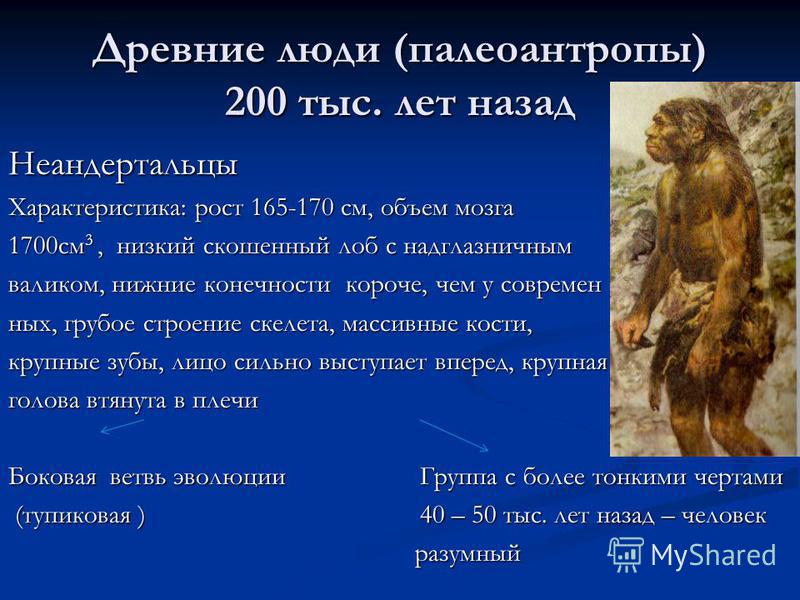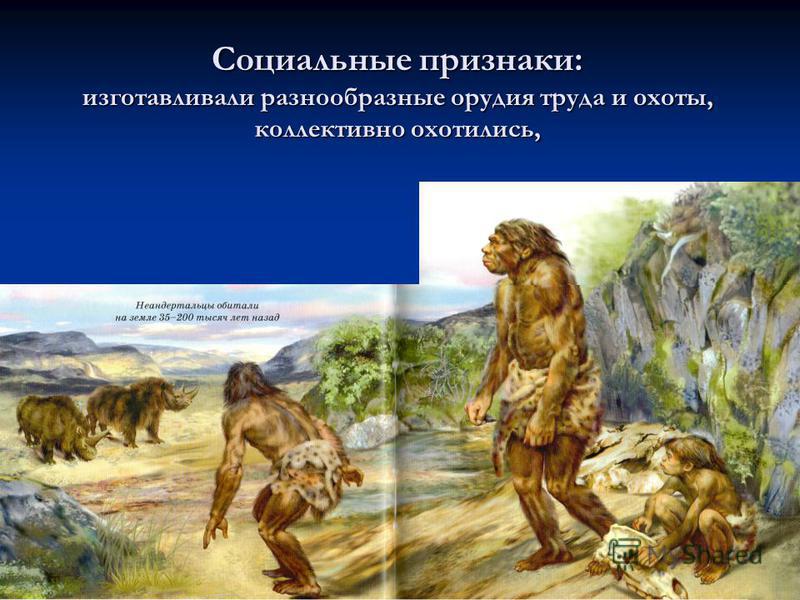This article will focus on the ancestors and closest relatives of modern man.
The topic is interesting and yet simple.

Dryopithecus
– literal translation: “tree monkeys”
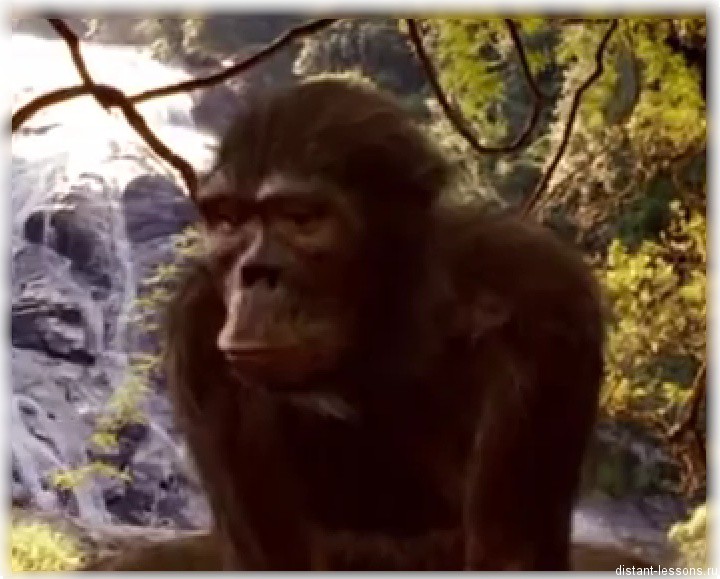
Common ancestor of modern humans and apes. They lived about 25 million years ago in Africa and Europe.
Outwardly, most likely, they were similar to modern chimpanzees.
Dryopithecus lived in herds, mainly in trees.
Due to the “arboreal” life, Dryopithecus and its descendants have some peculiarities:
forelimbs can rotate in all directions
This lifestyle was important for evolution:
the grasping function of the forelimb developed, which subsequently led to the ability to manipulate objects
- improved coordination, developed binocular color vision, life in the herd gave rise to the emergence of the public and, ultimately, to the emergence speeches;
Obrain volume clearly more than that of our ancestors;
at had teeth thin layer of enamel, which suggeststhat Dryopithecus ate plant foods (fruits, berries).
Australopithecus
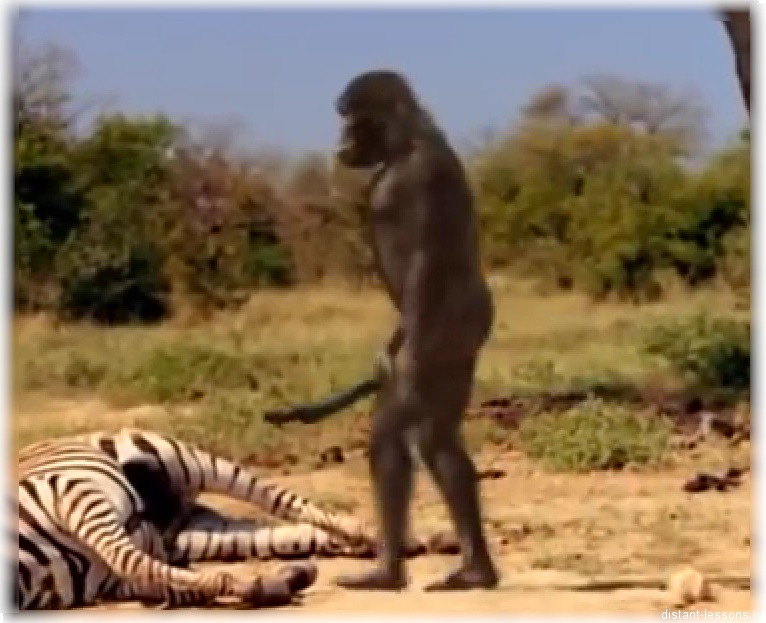
-transitional form from ape to man (or possibly relatives of the transitional form).
They lived about 5.5 million years ago.
Literal translation: “southern monkeys”, so named because its remains are found in southern Africa.
Australopithecines are already more “humanized” monkeys.
They walked on their hind legs, slightly hunched over.
they began to use primitive “tools”: stones, sticks, etc.
- the volume of the brain was approximately 400-520 cm 3, which is three times less than the volume of the modern human brain, but slightly larger than the brain volume of modern large apes;
- They were not tall: 110 – 150 cm, weight: 20 – 50 kg.
Australopithecus ate both plant and meat (less commonly).
- they knew how to hunt using “tools”;
life expectancy was short: 18 – 20 years;
Homo habilis (Homo habilis)
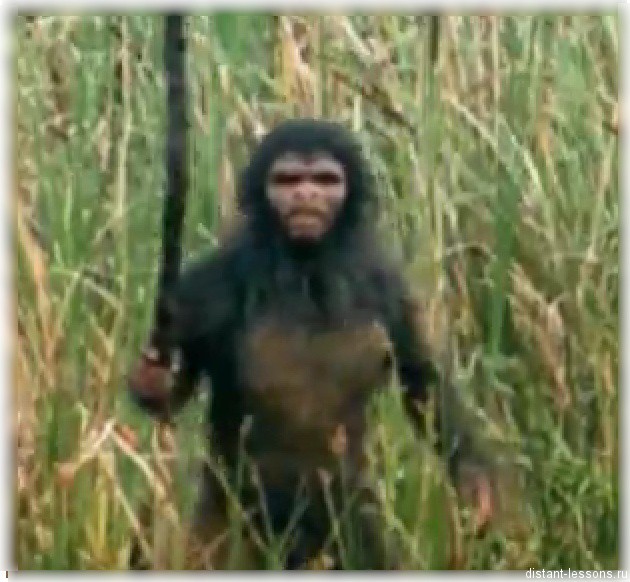
– possibly the first representative of the human race
According to alternative opinion Homo habilis is a representative of Australopithecines, since in appearance he is very similar to them.
Lived about 2 million years ago.
Possibly a descendant of one of the Australopithecus species. Skillful named because started making and consciously use tools. He selected raw materials for the manufacture of tools, which no animal can boast of.
- the volume of the brain, compared to Australopithecus, increased to approximately 600 cm 2, the facial part of the face of the skull decreased, “giving way” to the brain part;
- teeth smaller than those of australopithecines.
- a skilled person switched to euryphagy (omnivorous);
- the feet had an arch and became more adapted to walking on the hind limbs;
- the hand has become more adapted to grasping, the gripping power has increased;
- The larynx was not yet adapted for speech, but the part of the brain responsible for this function was already developed.
Homo erectus
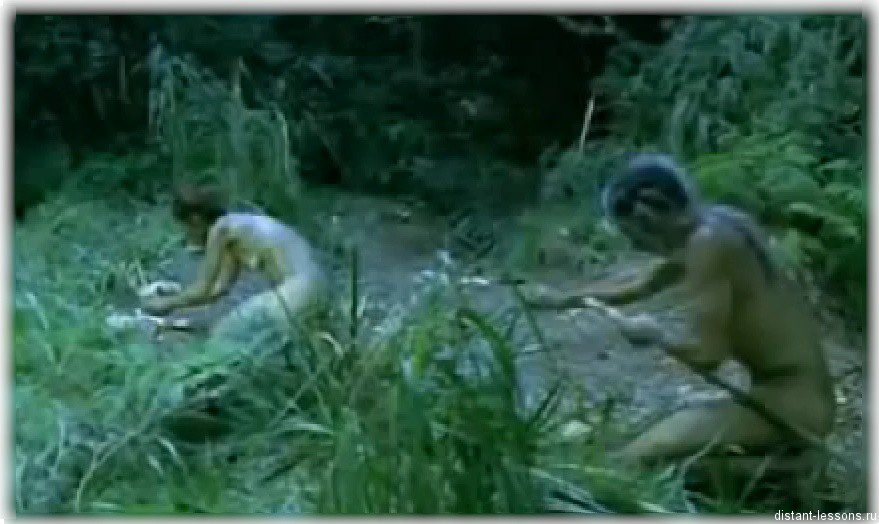
- already definitely a representative of the human race.
Lived approximately 1 million - 300 thousand years ago.
It is named so, as you might guess, because of the “final transition” to upright walking.
- he was already characterized by “human” qualities: speech and abstract thinking;
- Homo erectus has stepped far forward: his tools have become much more complex, he has mastered fire, some scientists suggest that he could even extract it on his own;
- Outwardly, Erectus was a little similar to modern man, but still different from him: scull had thick walls, the forehead was low with massive supraorbital protrusions, large, heavy lower jaw, the chin protrusion is slightly prominent;
- sexual dimorphism was less pronounced than in australopithecines, but still occurred: males were slightly larger than females.
- height was 150 - 180. Brain volume: approximately 1100 cm 3.
Homo erectus lived a hunter-gatherer lifestyle. They lived and hunted in groups - this helped in the development of speech and sociality. It is assumed that Homo erectus was supplanted by Neanderthal 300 thousand years ago, but the latest anthropological data rejects this.
Pithecanthropus(translated: ape man)
– a type of Homo erectus.
Lived in Southeast Asia 500-700 thousand years ago, was first discovered on the island of Java.
Pithecanthropus is not the ancestor of modern man, but rather our cousin.
Sinanthropus
- another variety of Homo erectus.
Lived 600-400 thousand years ago somewhere in the territory of modern China.
Sinanthropus became one of the last most developed representatives of the Homo erectus species. Some scientists are considered to be the ancestors of modern humans.
Neanderthal, Neanderthal Man
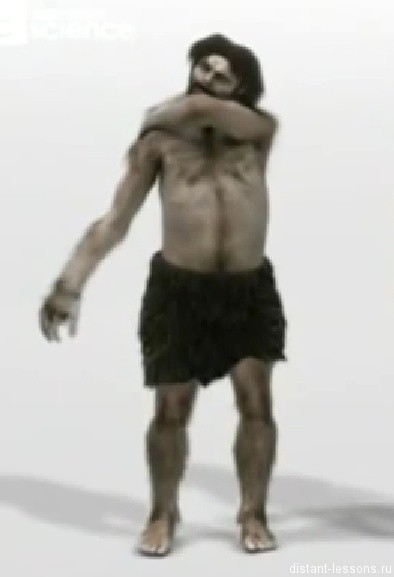
- a species of the human genus, previously considered a subspecies of Homo sapiens.
Lived in Europe and North Africa over 100 thousand years ago.
Neanderthals had a hard time, they lived during the Ice Age, so it’s no wonder that they learned to make houses and clothes. Neanderthals ate primarily meat. Neanderthal not a direct ancestor of Homo sapiens, although he may have lived next to the Cro-Magnons and could freely interbreed with them, thus leaving his “genetic trace” in modern representatives of the Human genus. It is also believed that there was a struggle between Cro-Magnons and Neanderthals, as a result of which the latter probably disappeared. It is likely that Cro-Magnons could hunt Neanderthals, and vice versa. Neanderthals were large, muscular creatures, more massive than Cro-Magnons.
- Neanderthal brain volume was 1200-1600 cm³.
- height: about 1.5 meters;
- the skull was elongated back (due to the large brain), but the forehead was low, the cheekbones were wide, the jaws were large, the chin, like that of the erectus, was weakly defined;
- the brow ridge protruded noticeably;
- Neanderthals developed a culture: the first religion (they buried brothers according to special rites), a musical instrument;
- Medicine began to appear: Neanderthals could treat fractures.
Cro-Magnon
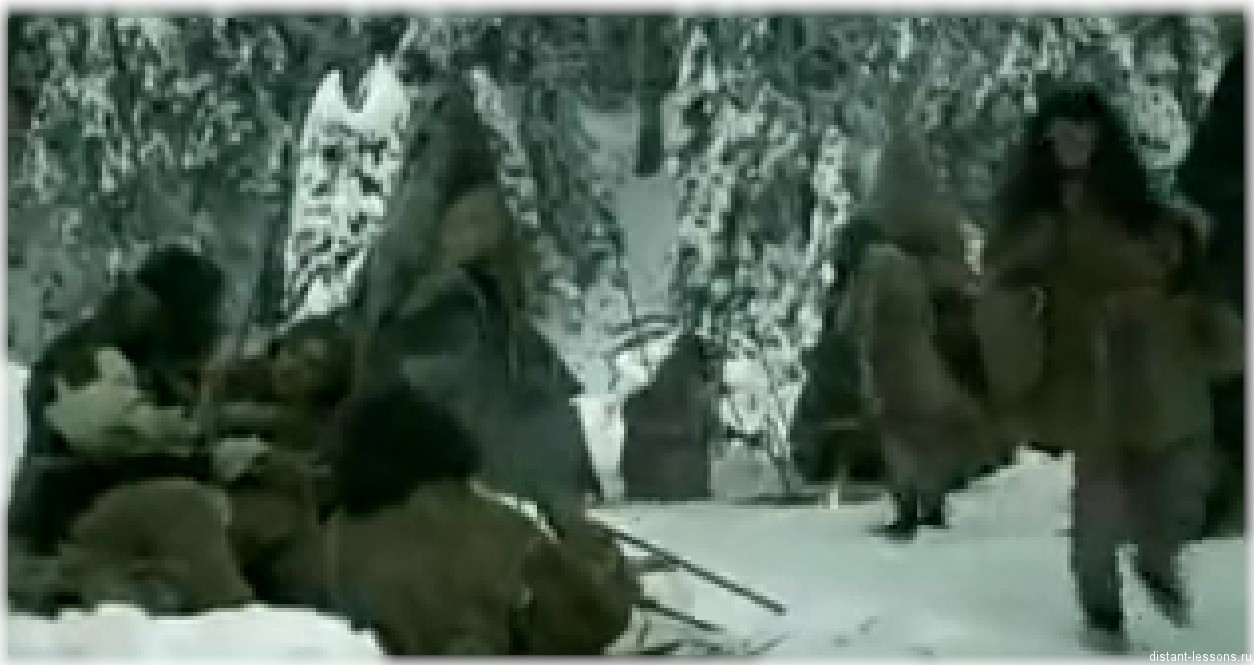
- the first representative of the species Homo sapiens, lived about 40 thousand years ago.
- Cro-Magnons had a definitively human appearance: a high, straight forehead, the brow ridge disappeared, and a chin protrusion appeared;
- Cro-Magnons were taller (height was about 180 cm) and less massive than Neanderthals;
- brain volume: 1400-1900 cm 3
- possessed articulate speech, formed the first “real” human society;
- lived the Cro-Magnons tribal communities 100 people each, creating the first settlements. They built dwellings: huts made of skins, dugouts. They made clothing, hunting tools: spears, snares, harpoons, and household items: knives, needles, scrapers. They were engaged in farming. They hunted collectively, using a revolutionary method: driven hunting. They began to domesticate animals;
- were highly developed culturally: they were engaged in rock painting and made sculptures from clay.
Just like the Neanderthals, they developed burial rituals, from which we can conclude that both believed in an afterlife. According to official science,Cro-Magnon is the direct ancestor of modern humans.
It took nature many millions of years to transform the monkey into modern man - the crown of creation. We are the result of a long evolutionary process, which we have just briefly skimmed over. Questions on this topic may appear in the State Examination Agency and the Unified State Examination. And we looked at this topic, I hope you found it interesting.
Currently, science has a significant amount of paleoanthropological, archaeological and geological data that makes it possible to illuminate the course of anthropogenesis (in general outline). Analysis of this information gives grounds to identify four conventional stages (segments) of anthropogenesis, characterized by a certain type of fossil man, the level of development of material culture and social institutions:
1) Australopithecines (predecessors of humans);
2) Pithecanthropus (ancient people, archanthropus);
3) Neanderthals (ancient people, paleoanthropes);
4) modern man, fossil and modern (neoanthropes).
In accordance with zoological taxonomy, the classification of hominids is as follows:
Family - Hominidae
Subfamily Australopithecinae - Australopithecus
Genus Australopithecus - Australopithecus
A. afarensis - A. afar A. robustus - A. powerful A. boisei - A boisei, etc.
Subfamily Homininae - Humans
Genus Homo - Man
N. erectus - Erect Man
N. sapiens neanderthalensis - Homo sapiens
N. sapiens sapiens - Homo sapiens sapiens.
Autralopithecus (predecessors of humans)
Paleontological and modern biological (to a greater extent) data have confirmed Darwin's theory of the origin of man and modern anthropologists from a common original form.
Establishing a specific hominoid ancestor remains a challenge modern science. Its existence is associated with a large group of African Dryopithecus that flourished in the Miocene - Pliocene (the Miocene extends within 22-27 million years, the Pliocene within 5-10 million years), originating from the Oligocene Aegyptopithecus (30 million years). In the 50-60s. one of the Dryopithecus, Proconsul, was put forward as a “model” of the common ancestor of hominids and pongids. Miocene Dryopithecus were semi-terrestrial, semi-arboreal apes that lived in tropical, mountain or common deciduous forests, as well as forest-steppe areas. Finds of Miocene and Lower Pliocene Dryopithecus are also known in Greece, Hungary and Georgia.
Two branches of evolution diverged from the common initial form: the first, pongid, led many millions of years later to modern apes, the second, hominid, ultimately led to the emergence of humans of the modern anatomical type. These two branches developed independently of each other over many millions of years in different adaptive directions. In accordance with natural and landscape conditions, each of them formed specific features biological organization corresponding to the way of life.
The branch of higher apes evolved in the direction of adapting to an arboreal lifestyle, to brachiatory type locomotion with all the ensuing anatomical features: lengthening of the forelimbs and shortening of the hind limbs, reduction of the thumb, lengthening and narrowing of the pelvic bones, development of ridges on the skull, sharp predominance of the facial region skull above the brain, etc.
The human branch of evolution, on the contrary, developed in the direction of adaptation to a terrestrial lifestyle, upright walking, liberation of the forelimbs from the function of support and locomotion, using them to use natural objects as tools, and later - to the manufacture of artificial tools, which was decisive in separation of man from the natural world. Performing these tasks required lengthening the lower and shortening the upper limbs, while the foot lost its grasping functions and turned into an organ of support for the straightened body, the brain, the main coordinating brain organ, rapidly developed, and accordingly the part of the skull became predominant; There is a disappearance of the ridges, the supraorbital ridge, the formation of a mental protuberance on the lower jaw, etc.
The next important question in evolutionary anthropology is: when did an independent branch of human evolution arise and who was its first representative? Averaging the estimates obtained by paleontologists and geneticists gives us a period of 8-6 million years. Geneticists calculate the timing of the separation of the two branches of evolution based on the genetic differences of modern hominoids and the estimated time of its origin.
Possible ancestors of hominids, in addition to Ramapithecus (the latter is often considered a link in the evolution of orangutans), are the European higher primates: Rudapithecus and Ouranopithecus, African Kenyapithecus (descendant of the more ancient proconsuls from the “dryopithecus circle”), lufengopithecus (Chinese Ramapithecus).
Australopithecines represent one of the first stages of human evolution. They may be considered by the most cautious investigators as the predecessors of all fossils and modern people. Australopithecus, the most interesting object in modern human paleontology, has become known to science since the 30s of our century. The first discovery of Australopithecus was made in the south of the African continent. It consisted of the remains of a skull and the natural cast of its brain part, belonging to a child.
Analysis of the “cub from Taung” showed that a number of structural features differ from the anthropoid type and at the same time resemble modern humans. The find caused a lot of controversy: some classified it as a fossil anthropoid, others as a fossil hominid. Subsequent discoveries of South African australopithecines demonstrated the presence of two morphological types - graceful and massive australopithecines. Initially they belonged to two independent genera. Currently, several hundred African Australopithecines are known. The South and East African massive and graceful variants of Australopithecus are classified as different species. The South African species lived between 3 and 1 million years, and the East African species lived for 4 or more - 1 million years.
Modern anthropologists have no doubt that Australopithecus is an intermediate type between apes and humans. The main difference from the first is bipedal locomotion, which is reflected in the structure of the skeleton of the body and some features of the skull (the middle position of the foramen magnum). The large width of the pelvic bones, associated with the attachment of the gluteal and part of the spinal muscles that straighten the trunk, proves the vertical position of the trunk. Part of the abdominal muscles that support the internal organs when walking with a straight body.
The landscape environment of australopithecines - steppe and forest-steppe - required the development of the ability to move on two legs. Sometimes anthropoids demonstrate this ability. For Australopithecus, bipedia was a permanent feature. It has been experimentally proven that bipedal gait is energetically more beneficial than other types of primate locomotion.
Signs of a modern type of human were identified on the lower jaws. Relatively small canines and incisors do not protrude above the general level of the teeth. Quite large molars have a “human” pattern of cusps on the chewing surface, referred to as the “dryopithecus pattern.” The structure of the teeth and the joint of the lower jaw indicate a predominance of lateral movements in the act of chewing, which is not typical of anthropoids. The jaws of Australopithecus are more massive than those of modern humans. The vertical profile of the facial region and its relatively small overall size are close to the human type. The eyebrow protrudes forward; the brain cavity is small; the occipital region tends to be rounded.
The volume of the brain cavity of australopithecines is small: gracial australopithecines - on average 450 cm3, massive australopithecines - 517 cm3, anthropoids - 480 cm3, i.e. almost three times less than that of modern humans: 1450 cm3. Thus, progress in brain development based on the absolute size of the brain in the Australopithecus type is practically not visible. The relative size of the brain of australopithecines, in some cases, was larger than that of anthropoids.
Among the South African forms, “Australopithecus africanus” and “Australopithecus powerful” stand out clearly. The latter can be characterized as follows: a stocky creature with a body length of 150-155 cm and a weight of about 70 kg. The skull is more massive than that of Australopithecus africanus, the lower jaw is stronger. A pronounced bony ridge on the crown served to attach strong masticatory muscles. The teeth are large (in absolute size), especially the molars, while the incisors are disproportionately small, so that the disproportion of the teeth is clearly visible. Such morphological features had a vegetarian Australopithecus, gravitating in its habitat to the forest line.
Australopithecus africanus had smaller sizes (graceful form): body length - up to 120 cm, and weight - up to 40 kg (Fig. I. 5). Judging by the bones of the body, the body position when walking was more straightened.
The structure of the teeth corresponded to adaptation to omnivory with a large proportion of meat food. Australopithecines were engaged in gathering and hunting, possibly taking advantage of the hunting trophies of other predators. When hunting baboons, Australopithecines used stones as throwing weapons. R. Dart created the original concept of pre-culture of australopithecines - “osteodontokeratic culture”, i.e. the constant use of parts of the animal skeleton as tools. It has been suggested that there is a complication mental activity Australopithecus: this was evidenced by the high level of their tool activity and developed gregariousness. The prerequisites for these achievements were upright walking and a developing hand.
Interesting are the finds of australopithecines and similar forms made in East Africa, in particular in the Olduvai Gorge (Tanzania). Anthropologist L. Leakey conducted research here for 40 years. He identified five stratigraphic layers that made it possible to establish the temporal dynamics of the earliest hominids and their culture in the early Pleistocene.
Initially, the skull of a massive australopithecus was discovered in Olduvai Gorge, named "Zinjanthropus bois" ("Nutcracker"), later renamed "Australopithecus bois". This find is confined to the upper half of layer I (age 2.3-1.4 million years). The archaic stone tools found here in the form of flakes with traces of retouching are noteworthy. Researchers were confused by the combination of lithic culture and the primitive morphological type of Australopithecus. Later, in layer I below Zinjanthropus, bones of the skull and hands of a more advanced type of human being were found. It was he, the so-called Homo habilis (Skilled Man), who owned the oldest Olduvai tools.
As for Zinjanthropus (A. boisei), in the evolution of australopithecines it continues the line of adaptation of massive forms to predominantly feeding on plant foods. This Australopithecus is larger than the “powerful Australopithecus” and is distinguished by a less perfect ability for bipedal walking (Fig. I. 6).
The fact of the coexistence of two types of early hominids, Australopithecus bois and Homo habilis, proven by fossil materials from the Olduvai Gorge, is of great importance, especially since they differ very noticeably in morphology and methods of adaptation.
The remains of Habilis in the Olduvai Gorge are not isolated: they are always adjacent to the pebble (Olduvai) culture, the oldest Paleolithic culture. Some anthropologists dispute the generic name
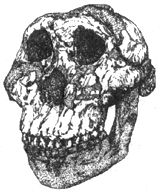
Rice. I. 6. Skull of supermassive Australopithecus (“Boycean”) (1.9 million years old)
habilis - "Homo", preferring to call it "Australopithecus habilis". For most experts, habilis is the oldest representative of the genus Homo. He not only used suitable objects from the surrounding nature for his needs, but also modified them. The antiquity of Homo habilis is 1.9 - 1.6 million years. Finds of this hominid are known in Southern and Eastern Africa.
Homo habilis had a body length of up to 120 cm, with a weight of up to 40-50 kg. The structure of the jaw reveals its ability to be omnivorous (a human characteristic). It differs from Zinjanthropus habilis in the large volume of the brain cavity (volume - 660 cm3), as well as the convexity of the cranial vault, especially in the occipital region. The lower jaw of Habilis is more graceful than that of other australopithecines, and the teeth are smaller. Due to fairly advanced bipedal walking, the big toe could move, like a human’s, only in the vertical direction, and the foot had arching. The body of the habilis was practically straightened. Thus, bipedia as one of the main achievements of anthropogenesis took shape very early. The hand changed more slowly. There is no perfect opposition of the thumb to the rest; its size, judging by the bone elements, is small. The phalanges of the fingers are curved, which is not typical for modern humans, but the terminal phalanges are flat.
In the layers of the Oluvai Gorge (age from 1.2-1.3 million years) bone remains of forms were found that can be interpreted as transitional from the type of progressive australopithecus to the type of Pithecanthropus. Pithecanthropus was also discovered in this location.
It is difficult to interpret and classify forms similar to the Australopithecines of Africa, but found outside this continent. Thus, on the island of Java, a fragment of the lower jaw of a great ape was discovered, the overall size of which significantly exceeded the size of modern humans and the largest apes. It was named "Meganthropus Paleo-Javanese". Currently, it is often classified as a member of the Australopithecus group.
All of these australopithecines and early representatives of the genus Homo were preceded in time by the graceful “Afarensis australopithecines” (A. afarensis), the bone remains of which were discovered in Ethiopia and Tanzania. The antiquity of representatives of this species is 3.9-3.0 million years. The fortunate discovery of a very complete skeleton of a subject named “Lucy” allows us to imagine Australopithecus afarensis as follows. The body dimensions are very small: body length - 105-107 cm, weight slightly exceeded 29 kg. The structure of the skull, jaws and teeth shows very primitive features. The skeleton is adapted to a bipedal gait, although different from that of humans. A study of foot prints in volcanic ash (at least 3.6 million years old) leads to the conclusion that Australopithecus afarans did not fully extend their legs at the hip joint, but crossed their feet when walking, placing them one in front of the other. The foot combines progressive features (large and adducted first toe, pronounced arch, formed heel) and ape-like features (the forefoot is not motionless). Upper proportions
and lower limbs correspond to upright walking, but there are clear signs of adaptation to the arboreal method of locomotion. In the hand, progressive features are also combined with archaic ones (relative shortening of the fingers), associated with the ability to move in trees. There are no signs of a “forceful grip” characteristic of hominids. As primitive features of the skull, one should note the strong protrusion of the facial region and the developed occipital relief. Even compared to other australopithecines, the protruding fangs and diastemas between the teeth of the upper and lower jaws look archaic. The molars are very large and massive. Absolute value the brain of “Australopithecus afarensis” is indistinguishable from the size of anthropomorphic monkeys, but its relative size is somewhat larger. Some individuals of the Afar people have a clear “chimpanzoid” morphology, proving the not so distant separation of the evolutionary branches of hominids and pongids.
Some neurologists believe that in very ancient representatives of australopithecines it is already possible to record a structural restructuring of the parietal, occipital and temporal regions of the brain; at the same time, among others, the external morphology of the brain is indistinguishable from that of apes. The restructuring of the brain could begin at the cellular level.
The most modern paleoanthropological discoveries make it possible to tentatively identify the species of Australopithecus, which preceded the “Afars” in time. These are the East African australopithecus A. ramidus (Ethiopia) (represented by the lower jaw) and A. anamensis (Kenya); (represented by fragments of the masticatory apparatus). The antiquity of both finds is about 4 million years. There are also more ancient finds of australopithecines that do not have a species definition. They fill the temporary hiatus between the earliest australopithecus and the hominoid ancestor.
Of great interest are the finds of early representatives of the genus Homo made on the eastern shore of the lake. Turkana (Kenya). The progressive features of Homo habilis “1470” include a brain volume of about 770 cm3 and a smoothed relief of the skull; antiquity - about 1.9 million years.
What place did tool activity occupy in the evolutionary achievements of australopithecines? Anthropologists do not have a consensus regarding the indissolubility of the connection between tool activity and bipedal walking. Despite the discovery of very ancient stone tool cultures, there is a significant gap in time between the appearance of bipedality and the emergence of labor. It is assumed that the reason for the separation of the first hominids from the animal world could be the transfer of the defensive function of the dental apparatus to artificial tools of defense, and the use of tools became an effective adaptation in the behavior of the first people who populated the savanna. Monuments of the Olduvai culture did not clarify the question of the connection of Australopithecines with Olduvai tools. Thus, it is known that the bones of the progressive “Habilis” and the massive Australopithecus were found in the same horizon with Olduvai tools.
The oldest tools were found in more ancient horizons than fragments of the first undisputed representatives of the genus Homo. Thus, Paleolithic cultures in Kenya and Ethiopia are 2.5-2.6 million years old. Analysis of new materials shows that australopithecines were only capable of using tools, but only representatives of the genus Homo were able to make them.
The Olduvai (Pebble) Age is the earliest in the Paleolithic (Old Stone Age). The most typical tools are massive archaic artifacts made from pebbles and stone fragments, as well as stone blanks (cores), tools on flakes. A typical Olduvai weapon is the chopper. It was a pebble with a beveled end, the unprocessed part of which served to hold the tool in the hand (Fig. I. 7). The blade could be processed on both sides; Tools with several edges and simple impact stones were also found. Olduvai tools differ in shape and size, but have the same type of blade. This is explained by the purposefulness of actions to develop tools. Archaeologists note that already from the beginning of the Paleolithic there was a set of tools for different purposes. Finds of broken bones suggest that Australopithecines were hunters. Olduvai tools survive into late times, especially in South and Southeast Asia. The long existence of Olduvai (1.5 million years) was almost unaccompanied technical progress. Australopithecines could create simple shelters such as wind barriers.
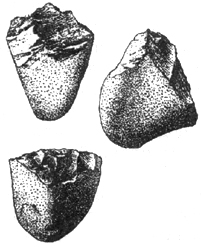
Rice. I. 7. Olduvai culture of the Lower Paleolithic. Pithecanthropus
(ancient people, archanthropes)
Pithecanthropus is the second stadia group of hominids after the Australopithecines. In this aspect, in the specialized literature they are often designated (all variants of the group) as “archanthropes,” i.e., “the most ancient people”; here we can also add the definition of “true people”, since the belonging of Pithecanthropus to the hominid family is not disputed by any anthropologist. Previously, some researchers combined Pithecanthropus with Neanderthals into one evolutionary stage.
Finds of Pithecanthropus are known in three parts of the world - Africa, Asia and Europe. Their ancestors were representatives of Homo habilis (late East African representatives of this species are often called Homo rudolfensis). The lifetime of Pithecanthropus (including the earliest, Homo ergaster) can be represented in the range of 1.8 million years - less than 200 thousand years. The most ancient representatives of the stage were discovered in Africa (1.6 million years - 1.8 million years); from the turn of 1 million years they were widespread in Asia, and from the time of 0.5 million years, Pithecanthropus (often called “pre-Neanderthals”, or representatives of Homo heidelbergensis) lived in Europe. The almost worldwide distribution of Pithecanthropus can be explained by their sufficient high level biological and social development. The evolution of different groups of Pithecanthropus occurred at different speeds, but had one direction - towards the sapient type.
For the first time, bone fragments of Pithecanthropus were discovered by the Dutch doctor E. Dubois on the island. Java in 1891. It is noteworthy that the author of the find shared the concept of an “intermediate link” in the human pedigree, which belonged to the Darwinist E. Haeckel. Near the village of Trinil, an upper molar, a skull cap and a femur were found (sequentially). The archaic character of the skull cap is impressive: a sloping forehead and a powerful supraorbital ridge and a completely modern type of femur. The layers containing the Trinil fauna date back to 700 thousand years (currently 500 thousand years). In 1894, G. Dubois first gave a scientific description of “Pitpecanthropus erectus” (“Ape-man erectus”). Some European scientists greeted such a phenomenal discovery with disbelief, and Dubois himself often did not believe in its significance for science.
With an interval of 40 years, other finds of Pithecanthropus were made on the island. Java and other locations. In the Pungat layers with the Jetis fauna near the village of Mojokerto, a child's skull of Pithecanthropus was discovered. The age of the find is close to 1 million years. Finds of skull and skeleton bones were made in the Sangiran locality (antiquity about 800 thousand years) during 1936-1941. The next series of finds at Sangiran dates back to the period 1952-1973. The most interesting find is the skull of Pithecanthropus with the preserved facial part of the skull, made in 1963. Remains of the Paleolithic culture on the island. Java not found.
A fossil man of a similar type to Pithecanthropus was discovered in the Middle Pleistocene deposits of China. The teeth of Sinanthropus (Chinese Pithecanthropus) were discovered in the limestone cave of Zhoukou-dian in 1918. The collection of random finds gave way to excavations, and in 1937 the remains of more than 40 individuals of Sinanthropus were discovered at this location (Fig. 1.8). The description of this variant of Pithecanthropus was first made by the Canadian specialist Vlecom. The absolute dating of Sinanthropus is estimated at 400-500 thousand years. The bone remains of Sinanthropus are accompanied by numerous cultural
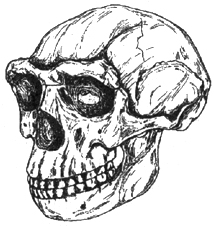
remains (stone tools, crushed and burnt animal bones). Of greatest interest is the multi-meter thick layer of ash found in the Sinanthropus hunting camp. The use of fire to process food made it more digestible, and maintaining a fire for a long time indicates a fairly high level of development of social relations among synanthropes.
Multiple finds allow us to confidently speak about the reality of the Pithecanthropus taxon. Let us present the main features of its morphotype. The modern type of femurs and the position of the foramen magnum, similar to what we see on modern skulls, indicate that Pithecanthropus undoubtedly adapted to upright walking. The overall massiveness of the skeleton of Pithecanthropus is greater than that of Australopithecus. Numerous archaic features are observed in the structure of the skull: highly developed relief, sloping frontal region, massive jaws, pronounced prognathism of the facial region. The walls of the skull are thick, the lower jaw is massive and wide, the teeth are large, and the size of the canine is close to modern ones. The highly developed occipital relief is associated with the development of the cervical muscles, which played a significant role in balancing the skull when walking. Given in modern literature Estimates of the size of the brain of Pithecanthropus vary from 750 to 1350 cm3, i.e., they approximately correspond at a minimum to the lower threshold of values given for Australopithecines of the Habilis type. Previously, the compared species were considered to be significantly different. The structure of the endocranes testified to the complexity of the brain structure: in Pithecanthropus, parts of the parietal region, lower frontal and upper posterior part of the frontal region are more developed, which is associated with the development of specific human functions - labor and speech. New foci of growth were discovered on the endocranes of synanthropes, associated with the assessment of body position, speech and fine movements.
Sinanthropus is somewhat different in type from Pithecanthropus. The length of its body was about 150 cm (pithecanthropus - up to 165-175 cm), the dimensions of the skull were increased, but the type of structure was the same, with the exception of a weakened occipital relief. The skeleton of Sinanthropus is less massive. The graceful lower jaw is noteworthy. Brain volume is more than 1000 cm3. The difference between Sinanthropus and Javan Pithecanthropus is assessed at the subspecies level.
The nature of food remains, as well as the structure of the lower jaws, indicates a change in the type of nutrition of synanthropes towards omnivory, which is a progressive feature. Synanthropes are likely to exhibit cannibalism. Archaeologists disagreed on their ability to make fire.
Analysis of human bone remains from this phase of anthropogenesis makes it possible to reconstruct the sex and age composition of synanthrope groups: 3-6 males, 6-10 females and 15-20 children.
The comparative complexity of culture requires a fairly high level of communication and mutual understanding, therefore, we can predict the existence of primitive speech at this time. The biological basis for this prognosis can be considered the strengthening of the bone relief in the places of attachment of the tongue muscles, the beginning of the formation of the chin, and the gracilization of the lower jaws.
Fragments of skulls of antiquity commensurate with the early Pithecanthropus of Fr. Java (about 1 million years old), found in two provinces of China - Lantian, Kuwanlin. It is interesting that the more ancient Chinese Pithecanthropus differs from Sinanthropus in the same way as the early Pithecanthropus from the later ones, namely, in greater massiveness of bones and smaller brain size. Late progressive Pithecanthropus includes a recent discovery in India. Here, together with Late Acheulean tools, a skull with a volume of 1300 cm3 was found.
The reality of the existence of the Pithecanthropus stage in anthropogenesis is practically not disputed. True, the later representatives of Pithecanthropus are considered the ancestors of subsequent, more progressive forms. The question of the time and place of the appearance of the first Pithecanthropus has been widely discussed in science. Previously, Asia was considered its homeland, and the time of its appearance was estimated at approximately 2 million years. Now this question solved differently. Africa is considered to be the homeland of both Australopithecus and Pithecanthropus. In 1984, a 1.6-million-year-old Pithecanthropus (a complete skeleton of an adolescent) was discovered in Kenya (Nariokotome). The main finds of the earliest Pithecanthropus in Africa are considered to be: Koobi Fora (1.6 million years), South African Swartkrans (1.5 million years), Olduvai (1.2 million years). African Pithecanthropus of the Mediterranean coast (Ternifin) is 700 thousand years old. The geological antiquity of the Asian variants can be estimated at 1.3-0.1 million years. There is archaeological evidence from sites in the Middle East, located closer to Africa than to Asia, indicating that the antiquity of African Pithecanthropus could reach 2 million years.
Synchronous forms of fossil humans from Europe are younger and quite distinctive. They are often called "pre-Neanderthals" or referred to as Homo heidelbergensis, which in Africa, Europe and Asia was the ancestor of modern humans and the Neanderthals of Europe and Asia. European forms have the following age: Mauer (500 thousand years), Arago (400 thousand years), Petralona (450 thousand years), Atapuerca (300 thousand years). Broken Hill (300 thousand years) and Bodo (600 thousand years) have a transitional evolutionary character in Africa.
In the Caucasus, the most ancient find in Georgia is considered to be the Dmanisi man, whose antiquity is estimated at 1.6-1.8 million years. Anatomical features allow us to put it on a par with the most ancient hominids of Africa and Asia! Pithecanthropes were also found in other sites: in Uzbekistan (Sel-Ungur), in the North Caucasus (Kudaro), Ukraine. A form intermediate between Pithecanthropus and Neanderthals was found in Azerbaijan (Azykh). The Acheulian man apparently lived on the territory of Armenia (Yerevan).
Early Pithecanthropus differs from later ones in having more massive bones and a smaller brain. A similar difference is observed in Asia and Europe.
In the Paleolithic, the Acheulean era correlates with physical type Pithecanthropus and early Neanderthals. The leading Acheulean weapon was a hand ax (Fig. I. 9). It demonstrates a high level in the development of stone processing technology. Within the Acheulean era, one can observe an increase in the careful finishing of handaxes: the number of chips from the surface of the tool increases. The surface treatment becomes finer when replacing stone bumpers with softer ones made of bone, horn or wood. The size of the hand ax reached 35 cm. It was made from stone by processing chips on both sides. The chopper had a pointed end, two longitudinal blades and a rough opposite edge. It is believed that the ax had a variety of functions: it served as a percussion instrument, was used for digging up roots, dismembering animal corpses, and processing wood. In the southern regions there is an ax (cleaver), distinguished by a transverse blade, not corrected by retouching, and symmetrically processed edges.
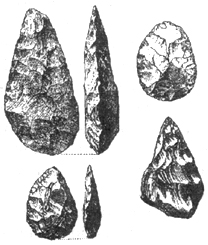
The typical Acheulean handaxe does not exhaust all the technological diversity characteristic of that period. There was a flake “Klekton” culture, as well as a flake progressive “Levallois” culture, which is distinguished by the manufacture of tools from flakes of disc-shaped stone blanks, the surface of the blanks was pre-processed with small chips. In addition to axes, small tools such as points, scrapers, and knives are found in Acheulean sites. Some of them survive to the time of the Cro-Magnons. Olduvai tools are also found in the Acheulean. Rare wooden tools are known. It is believed that the Pithecanthropus of Asia could make do with bamboo tools.
Hunting was of great importance in the life of the Acheuleans. Pithecanthropus were not only gatherers. Acheulean sites are interpreted as hunting camps, since bones of large animals are found in their cultural layer. The life of the Acheulian groups was difficult, people were engaged in different types labor. Various types of sites are open: hunting camps, flint mining workshops, long-term sites. The Acheulians built their dwellings in open areas and in caves. A settlement of huts has been opened in the Nice area.
The natural environment of Acheulean man determined the characteristics of material culture. The types of tools in different monuments are found in different proportions. Hunting large animals required close cohesion of a team of people. Sites of different types indicate the existence of a division of labor. The remains of the hearths indicate the effectiveness of the use of fire by Pithecanthropus. In the Kenyan site of Chesovanja, traces of fire are 1.4 million years old. The Mousterian culture of Neanderthal man is a development of the technological achievements of the angelic culture of Pithecanthropus.
As a result of the Afro-Asian migrations of the first people, two main centers of human evolution arose - Western and Eastern. Separated by vast distances, populations of Pithecanthropus could progress for a long time in isolation from each other. There is an opinion that Neanderthals were not a natural stage of evolution in all regions; in Africa and Europe, Pithecanthropus (“pre-Neanderthals”) were such.
Neanderthals (ancient people, paleoanthropes)
In the traditional stage model of anthropogenesis, the intermediate evolutionary stage between Homo erectus and Homo sapiens was represented by paleoanthropes (“ancient people”), who, in absolute chronology, lived in the period from 300 thousand years to about 30 thousand years in Europe, Asia and Africa. In non-professional literature they are often referred to as “Neanderthals”, after the name of one of the first finds in 1848 in the area of Neanderthal (Germany).
In general, paleoanthropes continue the line of evolution of “Homo erectus” (more precisely, Homo heidelbergensis), but in modern schemes they are often designated as a side branch of hominids. By general level evolutionary achievements, these hominids are closest to humans modern look. Therefore, they have undergone changes in their status in the classifications of hominids: paleoanthropes are currently considered as a subspecies of “Homo sapiens,” i.e., as its fossil version (Homo sapiens neanderthalensls). This view reflects new knowledge about the complexity of Neanderthal biology, intelligence, and social organization. Anthropologists giving great importance biological differences between Neanderthals and modern humans, they are still considered a special species.
The first discoveries of Neanderthals were made in the 19th century. in Western Europe and did not have an unambiguous interpretation.
Groups of paleoanthropes, located over a significant range of geological time, are very diverse in morphological appearance. Anthropologist V.P. Alekseev attempted to classify groups of Neanderthals that were morphologically and chronologically similar, and identified several groups: European, African, Skhul type and Western Asian. Most of the finds of paleoanthropes are known from Europe. Neanderthals often inhabited periglacial zones.
On the same grounds (morphological and chronological), among the European forms of this time, the following levels are distinguished: “the earliest Neanderthals” - “pre-Neanderthals”, “early Neanderthals” and “late Neanderthals”.
Anthropologists suggested that objectively there were multiple transitions between successive stage groups, therefore, in different areas, from several variants of Pithecanthropus, an evolutionary transition to paleoanthropus could have occurred. Representatives of the species Homo heidelbergensis could be predecessors (Petralona, Swanscombe, Atapuerca, Arago, etc.).
The earliest European group includes a fossil skull from the Steinheim site (200 thousand years old), found in Germany in 1933, as well as the Swanscombe female skull (200 thousand years old), discovered in England in 1935. These finds relate to the second interglacial according to the alpine scheme. Under similar conditions, a fossil lower jaw was found in France - the Montmorin monument. These forms are distinguished by the small size of the brain cavity (Steinheim - 1150 cm3, Swanscombe - 1250-1300 cm3). A complex of features has been identified that bring the earliest forms closer to modern humans: a relatively narrow and high skull, a relatively convex forehead, a massive eyebrow, like that of Pithecanthropus, not divided into its component elements, a rather rounded back of the head, a straightened facial region, the presence of a rudimentary chin of the lower jaw. There is obvious archaism in the structure of the teeth: the third molar is larger in size than the second and first (in humans, the size of the molars decreases from the first to the third). The bones of this type of fossil human are accompanied by archaic Acheulean tools.
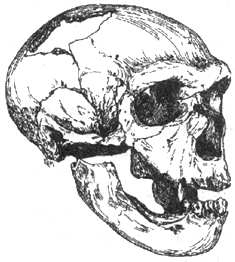
Many Neanderthals known to science belong to the last interglacial. The earlier of them lived about 150 thousand years ago. You can imagine their appearance based on finds from the European monuments of Eringsdorf and Saccopastore. They are distinguished by a vertical profile of the facial region, a rounded occipital region, a weakened superciliary relief, a rather convex forehead, and a relatively small number of archaic features in the structure of the teeth (the third molar is not the largest among the others). The brain volume of early Neanderthals is estimated at 1200-1400 cm3.
The existence of late European Neanderthals coincides with the last glaciation. The morphological type of these forms is clearly visible on the fossil bone remains of Chapelle (50 thousand years), Moustier (50 thousand years), Ferrassi (50 thousand years), Neanderthal (50 thousand years), Engis (70 thousand years), Circeo (50 thousand years), San Cesaire (36 thousand years) (Fig. I. 10).
This variant is characterized by a strong development of the eyebrow, a compressed occipital region from top to bottom (“chignon-shaped”), a wide nasal opening, and an expanded cavity of the molars. Morphologists note the presence of an occipital ridge, a chin protrusion (rarely and in rudimentary form), and a large volume of the brain cavity: from 1350 to 1700 cm3. Based on the bones of the skeleton of the body, one can judge that late Neanderthals had a strong, massive physique (body length - 155-165 cm). The lower limbs are shorter than those of modern humans, and the femurs are curved. The wide facial part of the skull of Neanderthals protrudes strongly forward and is sloping on the sides, the cheek bones are streamlined. The joints of the arms and legs are large. In terms of body proportions, Neanderthals were similar to the modern type of Eskimos, which helped them maintain body temperature in cold climates.
An interesting attempt is to transfer ecological knowledge about modern man to paleoanthropological reconstructions. Thus, a number of structural features of “classical” Neanderthals Western Europe explained as a consequence of adaptation to cold climate conditions.
It appears that the earliest and later forms from Europe are related genetically. European Neanderthals were discovered in France, Italy, Yugoslavia, Germany, Czechoslovakia, Hungary, Crimea and the North Caucasus.
To solve the question of the origin of modern man, the finds of paleoanthropes outside Europe, mainly in South-West Asia and Africa, are extremely interesting. The absence of specialization features in morphology in most cases distinguishes them from European forms. Thus, they are characterized by straighter and thinner limbs, less powerful supraorbital ridges, and shorter and less massive skulls.
According to one point of view, a typical Neanderthal man existed only within Europe and some regions of Asia, where he could have moved from Europe. Moreover, starting from the turn of 40 thousand years, Neanderthals coexisted with fully developed people of a modern anatomical type; in the Middle East, such coexistence could be longer.
The finds of paleoanthropes from Mount Carmel (Israel) are exceptional in significance. They attracted researchers with a mosaic of sapient and Neanderthaloid features. These finds can be interpreted as actual evidence of crossbreeding between early Neanderthals and modern humans. True, it should be noted that some of the Skhul finds are currently considered to belong to “archaic Homo sapiens”. Let's name some of the most famous finds.
Tabun is a fossil skull discovered in Tabun Cave, Mount Carmel. Antiquity - 100 thousand years. The skull is low, the forehead is sloping, there are supraorbital ridges, but the facial part and occipital region have a modern character. The curved limb bones resemble the type of European Neanderthals.
Skhul-V, antiquity - 90 thousand years (Fig. I. 11). The skull combines a large volume of the brain cavity and a fairly high forehead with a modern structure of the facial region and the back of the head.
Amud, antiquity - 50 thousand years. Found in the Amud cave near Lake Tiberias. (Israel). Has a large brain volume: 1740 cm3. The bones of the limbs are elongated.
Qafzeh, antiquity - about 100 thousand. years. Opened in Israel. Sapience is quite strongly expressed, so it is considered an accomplished sapiens.
In the north of Iraq, a Shanidar Neanderthal was discovered, classical in type, with a large brain section; researchers drew attention to the absence of a continuous supraorbital ridge. Age - 70-80 thousand years.
A Neanderthal man with traces of a funeral rite was found on the territory of Uzbekistan. The skull belonged to a boy with an unformed supraorbital ridge. The facial section and limbs of the skeleton, according to some anthropologists, are of a modern type. The location of the find is the Teshchik-Tash cave, antiquity - 70 thousand years.
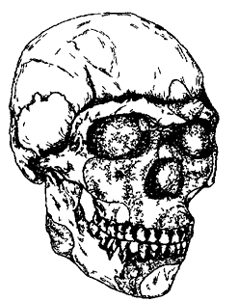
In Crimea, in the Kiik-Koba cave, the bone remains of an adult paleoanthrope (a type close to Western European Neanderthals) and a very young Neanderthal child were discovered. The bone remains of several Neanderthal children were discovered in the Crimea and in the area of Belogorsk. A fragment of the skull of a Neanderthal woman with some modern features, making it look like shul finds. Neanderthal bones and teeth were discovered in Adygea and Georgia.
The skull of a paleoanthropist was discovered in Asia - on the territory of China, in the Mala Grotto. It is believed that he cannot be attributed to any European variant of Neanderthals. The importance of this find lies in the fact that it proves the replacement of one stage type by another in the Asian part of the world. Another point of view is that in finds such as Mala, Chanyan, Ordos (Mongolia) we see transitional forms from Pithecanthropus to “early” sapiens. Moreover, this transition in some forms can be dated back to at least 0.2 million years (uranium method).
On about. In Java, near the village of Ngan-dong, peculiar skulls bearing traces of cannibalism were found. Researchers drew attention to their very thick walls and powerful supraorbital ridge. Such features make the Ngandong skulls similar to the type of Pithecanthropus. The existence of discovered hominids is the Upper Pleistocene (about 0.1 million years), i.e., they are synchronous with the late Pithecanthropus. There was an opinion in science that this was a local, unique type of Neanderthal, formed as a result of a slow evolutionary process. From other positions, the "Javanthropes" from Ngandong are defined as late Pithecanthropus, genetically related to the Late Pleistocene sapiens of Australia.
Until recently, it was believed that Neanderthals existed not only in the north, but also in the south of Africa. Hominids from Broken Hill and Saldanha were cited as examples of “southern” Africans. In their morphological type found general signs Neanderthals and Pithecanthropus. Their brain volume reached about 1300 cm3 (slightly less than the average for Neanderthals). It has been suggested that Broken Hill Man is a successor to the Olduvai Pithecanthropus from East Africa. Some anthropologists believed that there was a parallel line of paleoanthropic evolution in Southeast Asia and southern Africa. Currently, the Broken Hill variant is assigned the role of a fossil sapient form.
Changes in taxonomic views on later hominids have led to the fact that many forms preceding modern humans are classified as archaic Homo sapiens, often understood by this term as “pro-Neanderthals” (Swanscombe, Steinheim), then - peculiar African forms (Broken Hill, Saldanha), Asian (Ngandong), as well as European variants of Pithecanthropus.
Paleontological evidence suggests a mestizo origin for classical European Neanderthals. Apparently, there were two waves of migrants from Africa and Asia approximately 300-250 thousand years ago, with subsequent mixing.
The evolutionary fate of Neanderthals is unclear. The choice of hypotheses is quite wide: the complete transformation of Neanderthals into sapiens; complete extermination of Neanderthals by sapiens of non-European origin; crossbreeding of both options. Has the greatest support last point view that the emerging modern man migrated from Africa to Europe through Asia. In Asia it was recorded for about 100 thousand years, and came to Europe at the turn of 40 thousand years. Next, the assimilation of the Neanderthal population took place. The evidence is provided by European finds of hominids of Neanderthal appearance, modern type and intermediate forms. Early Neanderthals, penetrating into Western Asia, could interbreed with ancient sapiens there too.
Fossil odontological materials provide an idea of the scale of crossbreeding processes. They record the contribution of European Neanderthals to the gene pool of modern humans. Neanderthal fossil hominids coexisted with modern ones for tens of thousands of years.
The essence of the evolutionary transition that took place at the boundary of the Upper Paleolithic is explained in the hypothesis of Professor Ya.Ya. Roginsky.
The author summarizes data on the structure of the endocrane with clinical observations of modern humans and, on this basis, puts forward the assumption that the social behavior of paleoanthropes and modern humans is significantly different (control of behavior, manifestation of aggressiveness).
The Mousterian era, coinciding in time with the era of the Neanderthals, belongs to the Middle Paleolithic. In absolute terms, this time ranges from 40 to 200 thousand years. Mousterian tool assemblages are heterogeneous in the proportion of tools of different types. Mousterian sites are known in three parts of the world - Europe, Africa and Asia; bone remains of Neanderthals were also discovered there.
The technology of stone processing by Neanderthal man is distinguished by a relatively high level of technique for splitting and secondary processing of flakes. The pinnacle of technology is the method of preparing the surface of a stone blank and processing the plates separated from it.
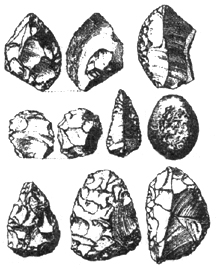
Careful adjustment of the surface of the workpiece entailed the thinness of the plates and the perfection of the tools obtained from them (Fig. 1.12).
The Mousterian culture is characterized by disc-shaped blanks, from which flakes were chipped radially: from the edges to the center. Most of Mousterian tools were made on flakes by secondary processing. Archaeologists count dozens of types of tools, but their diversity apparently boils down to three types: pointed, scraper, rubel. The point was a tool with a point at the end, used for cutting meat, leather, processing wood, and also as a dagger or spear tip. The side scraper was a flake, retouched along the edge. This tool was used for scraping or cutting when processing carcasses, hides or wood. Wooden handles were added to the scrapers. Toothed tools were used for turning wooden objects, cutting or sawing. In Mousterian one can find piercings, incisors, and scrapers—tools of the Late Paleolithic. The means of labor are represented by special chippers (elongated pieces of stone or pebbles) and retouchers (pieces of stone or bone for processing the edge of a tool by pressing).
Modern ethnographic research Australian Aborigines help to imagine the technological processes of the Stone Age. Experiments by archaeologists have shown that the technique of obtaining tool blanks in the form of flakes and plates was complex and required experience, technical knowledge, precise coordination of movements, and great attention.
Experience allowed ancient man to reduce the amount of time required to make tools. The technique of processing bone in Mousterian is poorly developed. Wooden tools were widely used: clubs, spears, spears with fire-hardened ends. Water vessels and elements of dwellings were made from wood.
Neanderthals were skilled hunters. At their sites, accumulations of bones of large animals were discovered: mammoths, cave bears, bison, wild horses, antelopes, and mountain goats. Complex hunting activities were within the power of a coordinated group of Neanderthals. The Mousterians used methods of rounding up or driving animals to cliffs and swamps. Complex tools were discovered - spearheads with flint fragments. Bolas were used as throwing weapons. The Mousterians practiced cutting up the carcasses of killed animals and roasting the meat over a fire. They made simple clothes for themselves. Gathering had a certain importance. The discovered grain grinders made of stone suggest that primitive grain processing existed. Cannibalism existed among Neanderthals, but was not widespread.
During Mousterian times, the nature of settlements changed. Sheds, grottoes and caves were more often inhabited. The types of Neanderthal settlements are identified: workshops, hunting and base sites. Wind barriers were installed to protect fires from the wind. In the grottoes, pavements were made from pebbles and pieces of limestone.
Bone remains of Neanderthals can be found together with Upper Paleolithic tools, as was the case, for example, with the discovery of a late paleoanthropus in France (the Saint-Césaire monument).
In the early Würmian era, Mousterian burials appeared on the territory of Eurasia - the first reliable traces of the burial of the dead. Today, about 60 such monuments have been opened. It is interesting that the “Neanderthal” and “sapient” groups more often buried adult individuals, and the “Neanderthal” population to the same degree Both adults and children were buried. The facts of burial of the dead give reason to assume the existence of a dualistic worldview among the Mousterians.
Modern man, fossil and modern (neoanthropes)
Fossil representatives of Homo sapiens sapiens are widely represented in known archaeological finds of hominid remains. The maximum geological age of fully formed neoanthropic fossils was previously estimated at approximately 40 thousand years (discovery in Indonesia). It is now believed that sapiens found in Africa and Asia were much more ancient (although we are talking about skeletons with archaic features expressed to varying degrees).
The bone remains of fossil humans of this subspecies are widespread: from Kalimantan to the tips of Europe.
The name “Cro-Magnons” (as fossil neoanthropes are designated in the literature) is due to the famous French Upper Paleolithic monument Cro-Magnon. The structure of the skull and skeleton of the body of fossil neoanthropes is, in principle, no different from modern humans, although their bones are more massive.
According to the analysis of bone material from Late Paleolithic burials, average age Cro-Magnons were 30-50 years old. The same life expectancy remained until the Middle Ages. Pathology of bones and teeth is less common than trauma (Cro-Magnon teeth were healthy).
Signs of differences between the skulls of Cro-Magnons and Neanderthals (Fig. 1.13): less protruding facial region, high convex crown, high straight forehead, rounded back of the head, smaller quadrangular eye sockets, smaller overall dimensions of the skull, a chin protrusion of the skull is formed; the brow ridge is absent, the jaws are less developed, the teeth have a small cavity. The main difference between Cro-Magnons and Neanderthals is the structure of the endocrane. Paleoneurologists believe that in late anthropogenesis the frontal regions of the brain, including behavioral control centers, developed. The internal connections of the brain were complicated, but the overall size of the brain decreased somewhat. Cro-Magnons were taller (169-177 cm) and less roughly built than Neanderthals.
![]()
Differences between Cro-Magnon skulls and modern ones: the height of the arch is smaller, the longitudinal dimensions are larger, the brow ridges are pronounced, the width of the eye sockets is larger, the facial part of the skull and lower jaw is wider, the thickness of the walls of the skull is greater. Upper Paleolithic man retained the features of the dental system characteristic of Neanderthals for quite a long time. The features that distinguish the skull and endocranium of Cro-Magnons from modern humans are often “Neanderthaloid” in nature.
Noteworthy is the fact that the distribution area of Cro-Magnon man is enormous: the entire ecumene. With the advent of Cro-Magnon man, as many experts believe, the species evolution of man ends, and the evolution of biological qualities for man in the future seems impossible.
The most complete finds of Cro-Magnon skeletons in Europe have an antiquity that does not exceed 40 thousand years. For example, the French neo-anthropist Cro-Magnon lived 30 thousand years ago, the Cro-Magnon man Sungir (Vladimir region) is 28 thousand years old. The archaic sapiens of Africa (with fairly pronounced Neanderthaloid features) look much older: Omo in Ethiopia - 130 thousand years, River Mouse (South Africa) - 120 thousand years, Border (South Africa) - more than 70 thousand years, Kenyan finds of sapiens - 200-100 thousand years, Mumba (Tanzania) - 130 thousand years, etc. It is assumed that the antiquity of African sapiens may be even greater. Asian finds of sapiens have the following age: Dali (PRC) - 200 thousand years, Jinnbshan (PRC) - 200 thousand years, Qafzeh (Israel) - more than 90 thousand years, Skhul V (Israel) - 90 thousand years, Nia (Kalimantan) - 40 thousand years. Australian finds are about 10 thousand years old.
It was previously assumed that modern humans arose in Europe about 40 thousand years ago. Today, a larger number of anthropologists and archaeologists place the ancestral home of sapiens in Africa, and the antiquity of the latter is greatly increased, focusing on the above findings. In accordance with the hypothesis of the German anthropologist G. Breuer, Homo sapiens sapiens appeared south of the Sahara about 150 thousand years ago, then migrated to Western Asia (at the level of 100 thousand years), and at the turn of 35-40 thousand years began to populate Europe and Asia, interbreeding with local Neanderthals. Modern biomolecular evidence also suggests that the ancestors of modern humanity came from Africa.
In accordance with modern evolutionary views, the most plausible model seems to be the “net evolution” of hominids, in which an important place is given to the exchange of genes between different subspecies and species of ancient humans. Therefore, very early finds of sapiens in Africa and Europe are interpreted as evidence of crossbreeding between sapiens species and Pithecanthropus. During the formation of the sapient type, a constant exchange of genes occurred between the primary centers of evolution of the genus Homo (Western and Eastern).
About 40 thousand years ago, the rapid spread of neoanthropus began. The reasons for this phenomenon lie in human genetics and the development of his culture.
Scientists studying Cro-Magnon man have to deal with a wide variety of types. Unanimous opinion on addition time modern races No. According to one point of view, the features of modern races are present in the Upper Paleolithic. This point of view is illustrated by examples of the geographical distribution of two characteristics - nasal protrusion and the degree of horizontal profiling of the facial region. According to another point of view, races took shape late, and the Upper Paleolithic population was distinguished by great polymorphism. Thus, for Europe, about 8 types of Upper Paleolithic races are sometimes distinguished. Two of them look like this: a) a dolichocranial, large-headed version of the Cro-Magnon with a moderate width of the face and a narrow nose; b) brachycranial (short-headed), with a smaller skull, a very wide face and a wide nose. It can be assumed that there were three stages in the formation of races: 1) the Middle and Lower Paleolithic - the formation of certain racial traits; 2) Upper Paleolithic - the beginning of the formation of racial complexes; 3) post-Paleolithic time - the addition of races.
The cultures of the Upper (Late) Paleolithic are associated with the appearance of modern humans (Neoanthropus). In Europe, the last period of the Paleolithic (ancient Stone Age) is estimated at 35-10 thousand years before the present day and coincides with the time of the last Pleistocene glaciation (this fact is the subject of discussion in connection with the problem of the role environment in the development of mankind) (Fig. I. 14).
At first glance, in the Paleolithic era under discussion there were no fundamental differences in material culture from previous eras: the same stone tools and hunting tools. In fact, the Cro-Magnons made a more complex set of tools: knives (sometimes daggers), spearheads, chisels, bone tools such as awls, needles, harpoons, etc. Bone tools made up about half of the total inventory; they were strong and more durable than stone ones. Stone tools were used to make tools from bone, wood, Ivory- this is how the technological chains in the actions of ancient man were complicated.
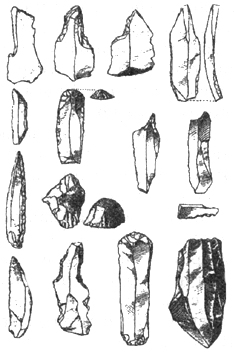
Completely new types of tools arose, such as needles with ears, fishhooks, harpoons, and spear throwers. They significantly strengthened man's power over nature.
The main difference of the Upper Paleolithic was the improvement of stone processing. In Mousterian times, there were several ways to process a stone blank (core). The Lavallusian technique of careful initial surface treatment of the workpiece is the start of the Upper Paleolithic technique. Cro-Magnons used blanks suitable for chopping series of plates (prismatic cores). Thus, during the Upper Paleolithic era, the technique of cleaving was improved, resulting in high-quality microblades suitable for use in composite tools.
Archaeologists have conducted experiments to reconstruct the method of separating the plates from the core, as the Cro-Magnons did. The selected and specially processed core was clamped between the knees, which acted as a shock absorber. The separation of the plates was carried out using a stone chipper and a bone mediator. In addition, flint flakes were separated by pressing on the edge of the core with a bone or stone squeezer.
The knife plate method is much more economical than the flake method. A skilled craftsman could separate from one piece in a short time more than 50 plates (length up to 25-30 cm, thickness - several millimeters). The working edge of the knife-shaped plate is much larger than that of the flake. More than 100 types of tools are known for the Late Paleolithic. It has been suggested that different Cro-Magnon workshops could differ in the originality of their technical “fashion”.
In the Upper Paleolithic, hunting was even more advanced than in Mousterian times. This played a huge role in increasing food resources, and, in connection with this, population.
A complete innovation was the spear thrower, which gave the Cro-Magnon hand an advantage in strength, doubling the distance over which the spear could be thrown (up to 137 m, with an optimal distance for hitting up to 28 m). Harpoons made it possible to effectively catch fish. The Cro-Magnon man invented snares for birds and traps for animals.
Perfect hunting was carried out for large animals: reindeer and ibex were pursued during their seasonal migrations to new pastures and back. Hunting techniques using knowledge of the area - driven hunting - made it possible to kill animals in the thousands. Thus, for the first time, an uninterrupted source of highly nutritious food was formed. The person got the opportunity to live in hard-to-reach areas.
In the construction of houses, the Cro-Magnons used the achievements of the Mousterians and improved them. This allowed them to survive the conditions of the last cold millennium of the Pleistocene.
European Cro-Magnons, populating the caves, used their good knowledge of the area. Many caves had access to the south, so they were well heated by the sun and protected from the cold northern winds. Caves were chosen near water sources, with a good view of pastures where herds of ungulates grazed. The caves could be used all year round or for seasonal stays.
Cro-Magnons also built dwellings in river valleys. They were made of stone or dug into the ground, the walls and roof were made of skins, and the supports and bottom could be lined with heavy bones and tusks. The Upper Paleolithic structure at the Kostenki site (Russian Plain), 27 m long, is marked by a number of hearths in the center, indicating that several families wintered here.
Nomadic hunters built light huts. Warm clothing helped the Cro-Magnons endure harsh climatic conditions. Images of people on bone artifacts suggest that they wore tight-fitting pants that retained heat, parkas with hoods, shoes and mittens. The seams of the clothes were well stitched.
The high intellectual development and psychological complexity of the Cro-Magnons is proven by the existence of numerous monuments of primitive art, which is known for the period of 35-10 thousand years in Europe. This refers to small sculptures and wall paintings in caves. Engravings of animals and people were made on stones, bones and deer antlers. Sculptures and bas-reliefs were made from clay and stone, and the drawings were made by the Cro-Magnons using ocher, manganese and charcoal. The purpose of primitive art is not clear. It is believed that it was of a ritual nature.
Burial studies provide abundant information about the life of Cro-Magnons. It was found, for example, that the life expectancy of Cro-Magnon man increased in comparison with Neanderthals.
Some Cro-Magnon rituals have been reconstructed. Thus, the custom of sprinkling the skeleton of the deceased with red ocher apparently testifies to belief in the afterlife. Burials with rich decorations suggest the emergence of wealthy people among hunter-gatherers.
An excellent example of a Cro-Magnon burial is provided by the Sungir monument near the city of Vladimir. The age of the burial is about 24-26 thousand years. Here lies an old man (“Leader”) in fur robes, richly decorated with beads. The second burial is interesting - a pair of children’s burials. The skeletons of the children were accompanied by spears made from mammoth tusks and were decorated with ivory rings and bracelets; the clothes are also decorated with beads.
Modern man and evolution
Since the completion of the formation of the species Homo sapiens (from the middle of the Upper Paleolithic), it has maintained stability in its biological status. The evolutionary completeness of man is relative and does not mean a complete cessation of changes in his biological properties. Various changes in the anatomical type of modern humans have been studied. Examples are a decrease in the massiveness of the skeleton, the size of the teeth, changes in the small toes, etc. It is assumed that these phenomena are caused by random mutations. Some anthropologists, based on anatomical observations, predict the appearance of Homo futurus - the “Man of the Future”, with a large head, a reduced face and teeth, and fewer fingers. But these anatomical “losses” do not characterize all human populations. An alternative view is that the biological organization of modern man allows for limitless social evolution, so it is unlikely to change as a species in the future.
The corresponding section of anthropology (the science of man) is also called.
Human ancestors. It is believed that the nearest common ancestor human and anthropomorphic monkeys were a group Dryopithecus (tree monkeys), lived 25-30 million years ago. There is a lot of indirect evidence to support this assumption. The ability of the human arm to rotate in all directions thanks to the ball-and-socket joint of the humerus could only have arisen in an arboreal form, and not in four-legged animals running on the ground. Only humans and primates have the ability to rotate the forearm in and out, as well as a well-developed clavicle. Humans and monkeys have developed skin patterns on their hands and feet that are found only in arboreal mammals.
Pongids, while remaining living in the forest, retained an arboreal lifestyle. The ancestors of hominids began to explore open spaces. The prerequisite for such a transition was the already acquired ability to live on land, the use of various objects for obtaining food and protection, and therefore the freeing of hands from participation in movement, the development of walking on two legs.
The formation of man as a biological species passed through four main stages - the predecessor of man (pro-tantrop); ancient man (archanthrope); ancient man (paleoanthropus); man of the modern type (neoanthropus) (Table 4.3).
Source : ON THE. Lemeza L.V. Kamlyuk N.D. Lisov "A manual on biology for those entering universities"
To date, there is no exact hypothesis about how and where they appeared. ancient human ancestors. Most scientists are of the opinion that humans and monkeys have a common ancestor. It is believed that somewhere 5-8 million years ago, the evolution of anthropoid apes went in two independent directions. Some of them remained to live in the animal world, and the rest, after millions of years, turned into people.
Rice. 1 - Human evolution
Dryopithecus
One of the ancient ancestors of man is Dryopithecus "tree monkey"(Fig. 2), who lived in Africa and Europe 25 million years ago. He led a herd lifestyle and was strikingly similar to a modern chimpanzee. Due to the fact that he constantly lived in trees, his forelimbs could turn in any direction, which played an important role in the further formation of man.
Features of Dryopithecus:
- developed upper limbs contributed to the emergence of the ability to manipulate objects;
- Coordination improved and color vision developed. There was a transition from a herd to a social way of life, as a result of which speech sounds began to develop;
- brain size increased;
- a thin layer of enamel on the teeth of Dryopithecus indicates the predominance of food of plant origin in its diet.
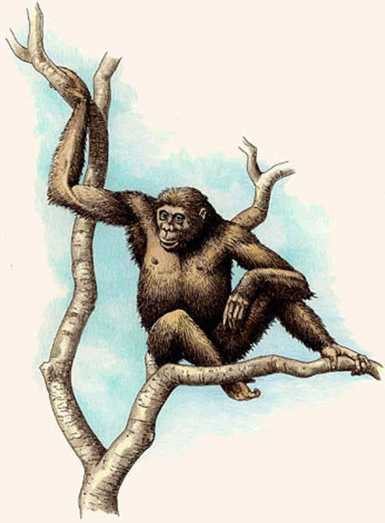
Rice. 2 - Dryopithecus - an early human ancestor
The remains of Australopithecus (Fig. 3) were discovered in Africa. Lived approximately 3-5.5 million years ago. He walked on his feet, but his arms were much longer than those of modern humans. The climate of Africa gradually changed and became drier, which resulted in a decrease in forests. More than half of the apes have adapted to new living conditions in open space. Due to the hot climate, ancient human ancestors, they mainly began to move on their feet, which saved them from overheating of the sun (the area of their back is much larger than the top of their head). As a result, this led to a decrease in sweating, thereby reducing water consumption.
Features of Australopithecus:
- knew how to use primitive objects of labor: sticks, stones, and so on;
- the brain was 3 times smaller than the brain of a modern person, but much larger than the brain of large monkeys of our time;
- was distinguished by his short stature: 110-150 cm, and body weight could be from 20 to 50 kg;
- ate plant and meat foods;
- earned his own food using tools he made himself;
- lifespan - 18-20 years.
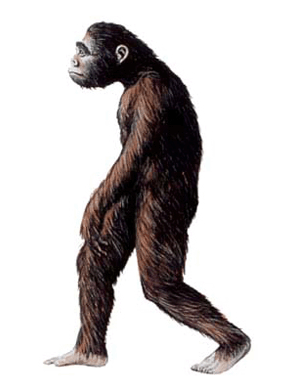
Rice. 3 - Australopithecus
(Fig. 4) lived approximately 2-2.5 million years ago. The posture of his figure was very close to that of a human. He walked in an upright position, which is where he got his second name - “homo erectus.” Habitat Africa, as well as some places in Asia and Europe. In the Olduvai Gorge (East Africa), things made from partially processed pebbles were discovered next to the remains of Homo habilis. This suggests that the ancient ancestors of man of that time already knew how to create simple objects of labor and hunting, and select raw materials for their manufacture. Presumably a direct descendant of Australopithecus.
Features of a “skillful” person:
- brain size - 600 cm²;
- the facial part of the skull became smaller, giving way to the brain part;
- the teeth are not very large, like those of Australopithecus;
- was an omnivore;
- the foot acquired an arch, which contributed to better walking on two limbs;
- the hand has become more developed, thereby expanding its grasping abilities, and the grip strength has increased;
- although the larynx was not yet able to reproduce speech, the part of the brain responsible for this was finally formed.
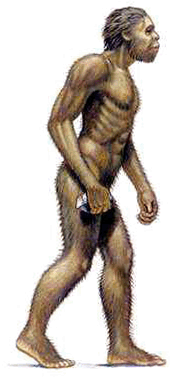
Rice. 4 - A “skillful” person
Homo erectus
Other name - Erectus(Fig. 5). Without a doubt he is considered a representative of the human race. Existed 1 million - 300 years ago. It got its name from the final transition to straight walking.
Features of Homo erectus:
- possessed the ability to speak and think abstractly;
- knew how to create quite complex objects of labor and handle fire. There is an assumption that an upright man could make fire on his own;
- appearance resembles the features of modern people. However, there are significant differences: the walls of the skull are quite thick, the frontal bone is located lower and has massive supraorbital protrusions. The heavy lower jaw is larger, and the chin protuberance is almost invisible;
- males were much larger than females;
- height is about 150-180 cm, brain size has increased to 1100 cm³.
The lifestyle of the erect walking ancestor of man consisted of hunting and gathering edible plants, berries, and mushrooms. inhabited social groups, which contributed to the formation of speech. Perhaps it was supplanted by Neanderthals 300 thousand years ago, but this version does not have solid arguments.
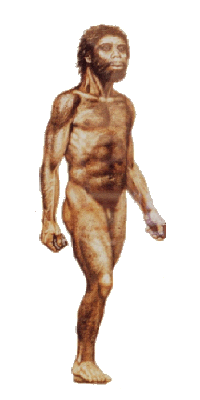
Rice. 5 - Erectus
Pithecanthropus
Pithecanthropus - is rightfully considered one of ancient human ancestors. This is one of the varieties of upright man. Habitat: Southeast Asia, lived about 500-700 thousand years ago. The remains of the “ape-man” were first found on the island of Java. It is assumed that he is not a direct ancestor of modern humanity, most likely he can be considered our “cousin”.
Sinanthropus
Another species of Homo erectus. Existed 600-400 thousand years ago in the current territory of China. Sinanthropus are relatively developed ancient ancestors of humans.
A representative of the human race, he was previously considered a subspecies of Homo sapiens. Its habitat is Europe and North Africa more than 100 thousand years ago. The period of life of the Neanderthals fell precisely during the Ice Age, respectively, in the harsh climatic conditions they had to take care of making clothes and building housing. The main food is meat. It does not relate to the direct relationship of Homo sapiens, but it could well have lived next to the Cro-Magnons, which contributed to their mutual crossing. Some scientists believe that there was a constant struggle between Neanderthals and Cro-Magnons, which led to the extinction of Neanderthals. It is assumed that both species hunted each other. Neanderthals (Fig. 6) had a massive, large physique, compared to Cro-Magnons.
Features of Neanderthals:
- brain size - 1200-1600 cm³;
- height - approximately 150 cm;
- due to the large brain, the skull had an elongated backward shape. True, the frontal bone was low, the cheekbones were wide, and the jaw itself was large. The chin had a weakly defined character, and the brow ridge had an impressive protrusion.
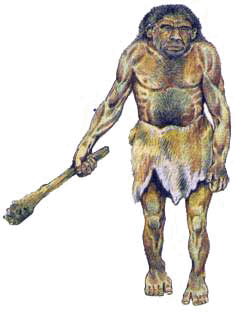
Rice. 6 - Neanderthal
Neanderthals led cultural life: were discovered during excavations musical instruments. Religion was also present, as indicated by special rituals at the funerals of their fellow tribesmen. There is evidence that these ancient human ancestors had medical knowledge. For example, they knew how to heal fractures.
Direct descendant of Homo sapiens. Existed approximately 40 thousand years ago.
Features of Cro-Magnons (Fig. 7):
- had a more developed human appearance. Distinctive features: fairly high straight forehead, absence of a brow ridge, a more distinctly shaped chin protuberance;
- height - 180 cm, but body weight is much less than that of Neanderthals;
- brain size was 1400-1900 cm³;
- spoke clearly;
- considered the founder of the first true human cell;
- lived in groups of 100 people, so to speak, tribal communities, building the first villages;
- engaged in the construction of huts and dugouts, using the skins of killed animals. He created clothing, household items and hunting tools;
- knew agriculture;
- he went hunting with a group of fellow tribesmen, chasing and driving the animal into a prepared trap. Over time, he learned to domesticate animals;
- had its own highly developed culture, which has survived to this day in the form of rock paintings and clay sculptures;
- performed rituals during the burial of relatives. It follows from this that the Cro-Magnons, like the Neanderthals, believed in another life after death;
Science officially believes that the Cro-Magnon man is a direct descendant of modern people.
The ancient ancestors of humans will be discussed in more detail in the following lectures.
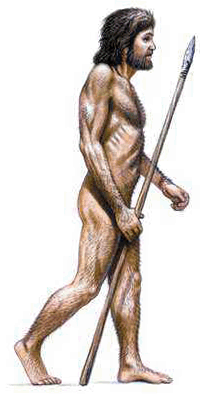
Rice. 7 - Cro-Magnon
Assignment Compile a generalized table on the topic: “Stages of human evolution and their characteristics” Stage Groups Chronological age Locations of finds Structural features Lifestyle Dryopithecus Australopithecus Homo habilis Archanthrope Paleoanthrope Modern type man

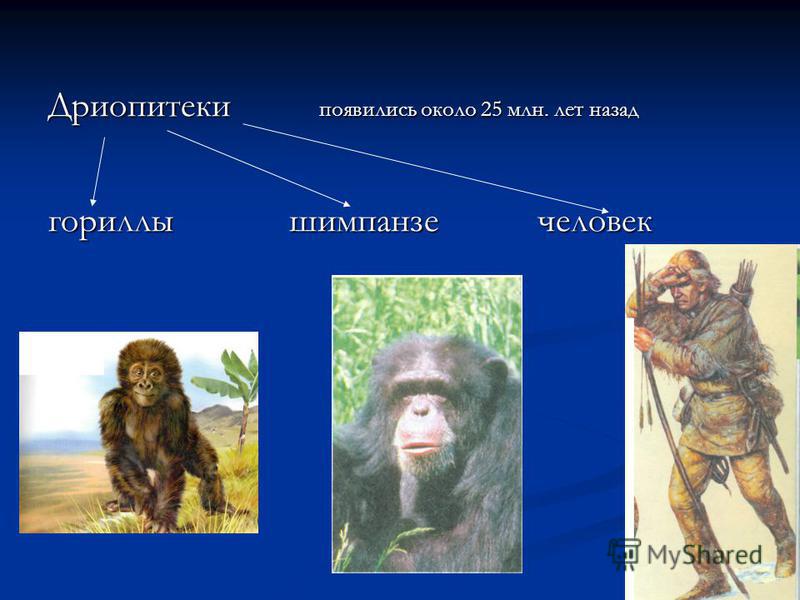
Features of Dryopithecus Small, lived in trees, Small, lived in trees, fed on plants and insects fed on plants and insects Movable cyst with opposable First toe Movable cyst with opposable first toe Developed shoulder girdle, sufficiently Developed shoulder girdle, sufficiently large amplitude of movements large amplitude of movements There is a collarbone There is a collarbone Rib cage wide and flattened in the dorso-abdominal direction The chest is wide and flattened in the dorso-abdominal direction Strong development of the brain Strong development of the brain Closed eye sockets (binocular vision) Closed eye sockets (binocular vision) Limited fertility, careful care of offspring Limited fertility, careful care for offspring
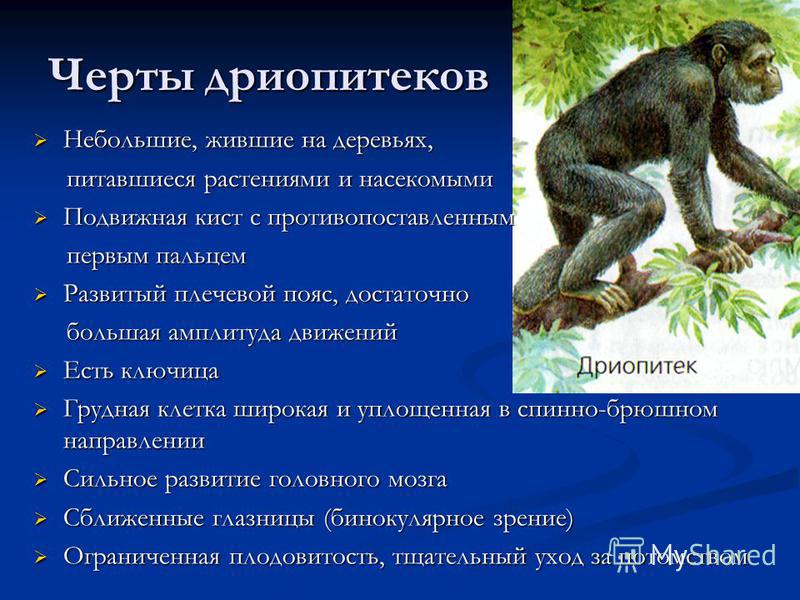
Staged concept of anthropogenesis Human evolution, which is a series of time-sequential types, each of which was characterized by certain features, the level of development of material culture, social behavior, consciousness, speech, etc.

Australopithecus - the northern branch of Dryopithecus Bipedal gait, life in the savannah Bipedal gait, life in the savannah Teeth are close to human teeth, ate meat Teeth are close to human teeth, ate meat Body weight - kg, height - cm Body weight - kg, height - cm Weight of the brain – 550 g Weight of the brain – 550 g Could use natural objects as tools for defense and attack Could use natural objects as weapons for defense and attack
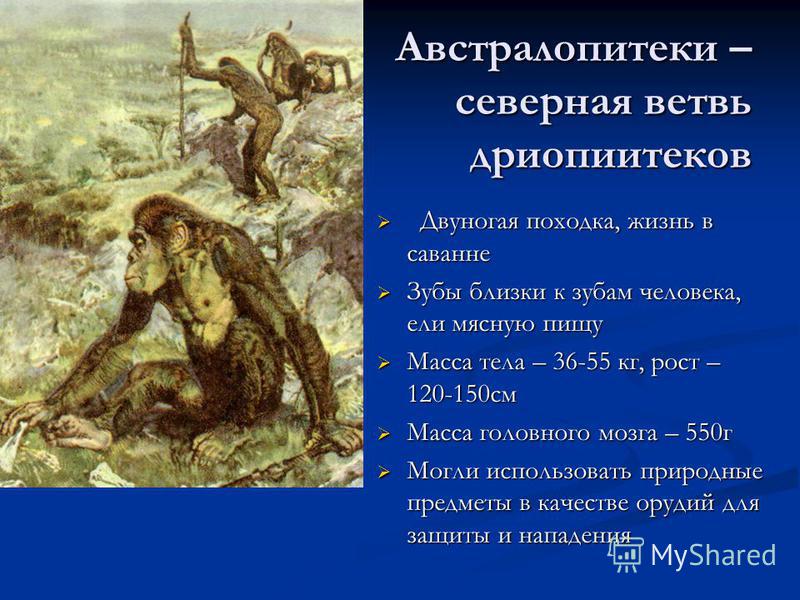
Characteristics of Australopithecus 7 - 8 million years ago - separation of the ape and human branches 7 - 8 million years ago - separation of the ape and human branches Australopithecus (from Latin australis - southern) Australopithecus (from Latin australis - southern) In 1924 Kalahari R.A. Dart discovered the bones of an ape that lived 3 - million years ago gracile progressive (omnivorous) Homo habilis massive massive (herbivorous)
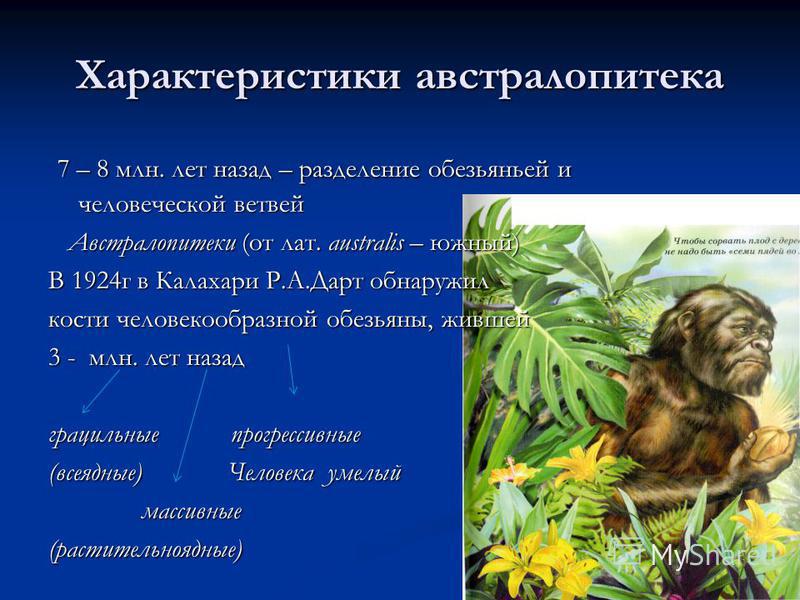

The earliest people(ape-people or archanthropes) 2 - 1.3 million years ago Pithecanthropus (from the Greek pithekos - monkey) Pithecanthropus (from the Greek pithekos - monkey) Characteristics: height cm, brain volume cm 3, sloping forehead, supraorbital ridge, sloping forehead , supraorbital ridge, upright posture, formation of speech, upright posture, formation of speech, but there is no chin protrusion, but there is no chin protrusion, maintaining and using fire, maintaining and using fire, lived in primitive herds, lived in primitive herds, made primitive tools. made primitive tools.
![]()
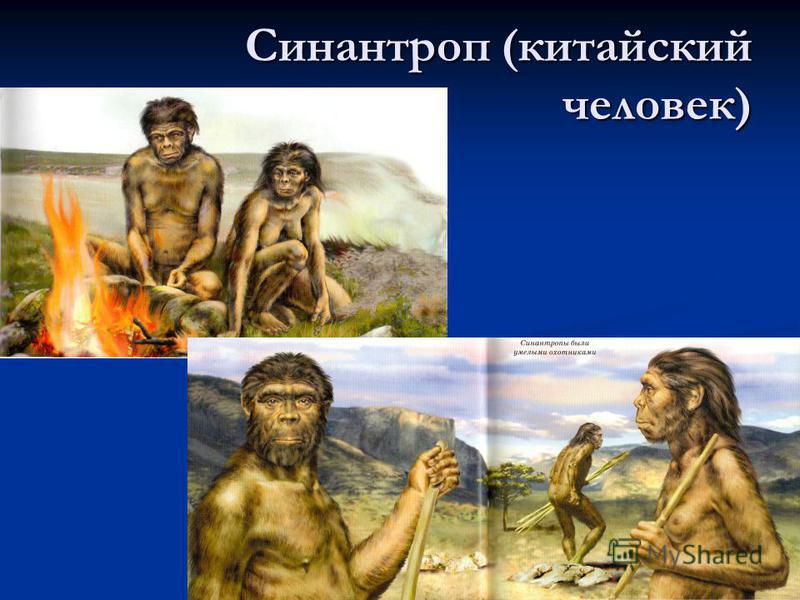
Ancient people (paleoanthropes) 200 thousand years ago Neanderthals Characteristics: height cm, brain volume 1700 cm3, low sloping forehead with supraorbital ridge, lower limbs shorter than modern ones, rough skeletal structure, massive bones, large teeth, face protrudes strongly forward, large head pulled into the shoulders Lateral branch of evolution Group with more subtle features (dead-end) 40 - 50 thousand years ago - man (dead-end) 40 - 50 thousand years ago - homo sapiens sapiens
